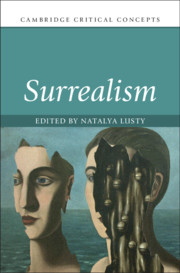Book contents
- Surrealism
- Cambridge Critical Concepts
- Surrealism
- Copyright page
- Contents
- Illustrations
- Notes on Contributors
- Acknowledgments
- Introduction: Surrealism’s Critical Legacy
- Part I Origins: Ideas/Concepts/Interventions
- Part II Developments: Practices/Cultures/Material Forms
- Chapter 7 Surrealist Collections in Paris and Sussex
- Chapter 8 Surrealist Objects
- Chapter 9 Collage
- Chapter 10 Film
- Chapter 11 Photography in Surrealism
- Chapter 12 Surrealist Fashion
- Chapter 13 Surrealist Display Practices
- Part III Applications: Heterodoxies and New Worlds
- Select Bibliography
- Index
Chapter 9 - Collage
from Part II - Developments: Practices/Cultures/Material Forms
Published online by Cambridge University Press: 23 July 2021
- Surrealism
- Cambridge Critical Concepts
- Surrealism
- Copyright page
- Contents
- Illustrations
- Notes on Contributors
- Acknowledgments
- Introduction: Surrealism’s Critical Legacy
- Part I Origins: Ideas/Concepts/Interventions
- Part II Developments: Practices/Cultures/Material Forms
- Chapter 7 Surrealist Collections in Paris and Sussex
- Chapter 8 Surrealist Objects
- Chapter 9 Collage
- Chapter 10 Film
- Chapter 11 Photography in Surrealism
- Chapter 12 Surrealist Fashion
- Chapter 13 Surrealist Display Practices
- Part III Applications: Heterodoxies and New Worlds
- Select Bibliography
- Index
Summary
The principle and technique of collage as the juxtaposition of disparate elements is generally considered to be the fundamental model of twentieth-century avant-garde art forms. As structure rather than representation it ranges from Picasso’s cubist works to Rauschenberg’s combines; and within Surrealism, from Joan Miro’s pasted papers to George Hugnet’s “poèmes découpés.” This chapter argues that verbal and visual collage is at the heart of Surrealism’s revolutionary project, the means of contesting the established order, by imaginatively reconfiguring signs to produce new meanings – poetic, erotic, or satirical. Various questions regarding collage are explored. What are its limits? Can the concept embrace Dalí’s assemblages, film montage, Breton’s display of objects, or examples of citation, parody, or pastiche? Can it be defined as an experimental form rather than an aesthetic object, a dynamic process rather than a finished product? If collage is considered a collective activity, can it be identified with intertextuality? Finally, the chapter examines critical interpretations of collage by the surrealists themselves and explores examples of postsurrealist collage.
Keywords
- Type
- Chapter
- Information
- Surrealism , pp. 176 - 190Publisher: Cambridge University PressPrint publication year: 2021

